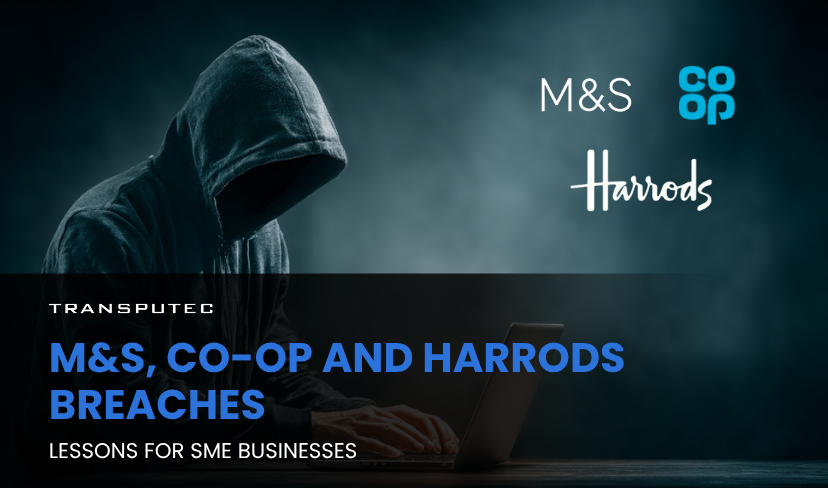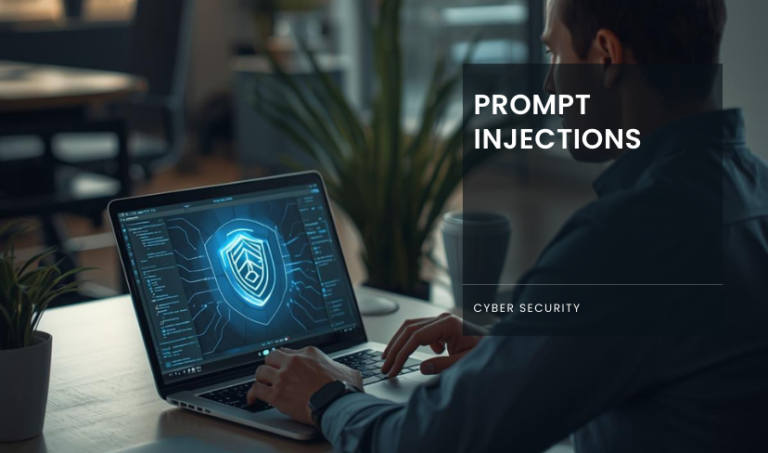Written by CYBERSECURITY SPECIALIST | TRANSPUTEC
A single email, a careless password reset, or one unverified phone call—that’s all it took for cybercriminals to breach household names like Marks & Spencer (M&S), the Co-operative Group (Co-op), and Harrods. These incidents disrupted operations, leaked sensitive customer data, and cost millions in lost revenue and reputational damage. For small and medium-sized enterprises (SMEs), this is more than a headline; it’s a warning.
Cybersecurity isn’t only about defending servers—it’s about protecting trust, continuity, and credibility. This blog examines what happened during the M&S, Co-op and Harrods breaches, how these attacks unfolded, and what vital lessons SMEs can learn to prevent becoming the next target. You’ll also find actionable strategies, backed by data and expert insight, that any business can apply right now.
How the M&S, Co-op and Harrods Breaches Happened?
The M&S, Co-op and Harrods breaches weren’t caused by sophisticated zero-day exploits or cutting-edge malware. Instead, they relied on social engineering—the art of manipulating people into granting unauthorised access.
According to the UK Cyber Security Breaches Survey 2025, over 83% of businesses that experienced a cyber incident reported phishing or impersonation attempts as the initial entry point. In these breaches, attackers impersonated IT staff, tricking helpdesk employees into resetting internal credentials. Once inside, they deployed ransomware and threatened data exposure unless paid.
The motive was simple: financial gain through extortion and disruption.
Understanding the M&S, Co-op and Harrods Breaches
1. Marks & Spencer (M&S): When a Trusted Brand Faces Ransomware
In April 2025, M&S became the target of a ransomware attack by the cybercriminal group known as Scattered Spider. The attackers used “DragonForce” ransomware to infiltrate the retailer’s systems, stealing personal information such as customer names, addresses, and order details.
While payment data remained encrypted, M&S had to suspend online operations for several days, impacting both revenue and customer confidence. Analysts at Bloomberg estimated a market value drop exceeding £1.2 billion within a week of the breach.
This incident exposed a harsh truth: even established companies with advanced IT budgets can fall victim to basic security gaps, often caused by human error or social engineering.
2. The Co-op Breach: Operational Disruption at Scale
Shortly after the M&S breach, Co-op suffered a similar attack. This time, ransomware crippled its logistics and ordering systems, leading to product shortages across hundreds of stores. Internal reports suggested that attackers gained entry by posing as IT support staff—a tactic that tricked employees into resetting passwords and granting access to internal networks.
Although payment systems were largely unaffected, the operational impact was significant. Rural stores reported shortages of essential goods for several days, and customer complaints flooded social media.
This breach proved that business continuity is just as important as data protection. Without functioning systems, even a business with intact data can face severe losses.
3. Harrods: A Near Miss with a Valuable Lesson
Unlike M&S and Co-op, Harrods managed to detect and neutralise an attempted cyberattack before any data loss occurred. Their internal security team acted quickly, isolating systems and restricting network access across branches. While the precautionary shutdown caused temporary disruption, the response demonstrated the value of proactive monitoring and trained personnel.
This incident shows that prevention is possible when detection systems and decision-making frameworks are strong.
Why These Breaches Matter for SMEs?
While global brands like M&S, Co-op, and Harrods have resources to recover, most SMEs do not. The Federation of Small Businesses (FSB) reports that the average cost of a cyberattack on an SME is £8,170, but many never reopen after a severe breach.
The M&S, Co-op and Harrods breaches highlight three core lessons:
- Attackers exploit human error, not just software flaws.
- Cyber resilience is more than technology—it’s process and people.
- Reactive security costs more than proactive protection.
Lessons SMEs Can Learn from M&S, Co-op and Harrods Breaches
1. Build a Security-First Culture
Human behaviour remains the weakest link in any security chain. Regular awareness training helps employees recognise suspicious requests, phishing attempts, and impersonation tactics.
At Transputec, we’ve found that clients who implement quarterly staff training reduce phishing success rates by over 70% within six months.
Encourage a “stop and verify” culture—no password resets, file downloads, or data disclosures without confirming the source.
2. Implement Multi-Factor Authentication (MFA)
Both M&S and Co-op suffered breaches through compromised credentials. MFA adds an extra layer of protection by requiring a secondary verification method, such as a mobile code or biometric check.
Microsoft reports that MFA can block 99.2% of automated attacks. For SMEs, enabling MFA across cloud platforms, email accounts, and business applications is one of the simplest yet most effective defences.
3. Prioritise Incident Response Readiness
During the M&S, Co-op and Harrods breaches, the speed of response determined the severity of damage. Harrods’ quick action limited the fallout, while M&S and Co-op suffered extended downtime.
An incident response plan should outline:
- Who to contact during a breach
- How to isolate affected systems
- Steps to restore operations
- Communication protocols for customers and partners
Transputec recommends running cyber drills twice a year, simulating real scenarios to ensure teams are prepared.
4. Adopt Continuous Monitoring and Threat Detection
Modern attacks are dynamic. Continuous network monitoring helps detect unusual behaviour—like unauthorised access attempts—before damage occurs.
Solutions powered by AI-driven analytics, such as Managed Security Operations Centres (SOCs), allow real-time threat detection and response. SMEs that adopt managed cybersecurity services typically reduce breach detection time by up to 60%, according to Gartner.
5. Secure Supply Chain Dependencies
The M&S, Co-op and Harrods breaches revealed how third-party systems can amplify risk. SMEs often rely on external vendors for logistics, payroll, or IT support, yet few verify their security standards.
Request evidence of certifications such as ISO 27001 or Cyber Essentials, and ensure your partners maintain encryption and secure access protocols.
6. Backups and Recovery Testing
Ransomware thrives when organisations lack clean backups. Regular, encrypted backups—stored offline or in a secure cloud—can help restore operations without paying a ransom.
Transputec’s cybersecurity specialists recommend testing backup restoration quarterly to ensure data integrity and speed of recovery.
Don’t Wait Until It’s Your Business in the Headlines
The recent breaches at M&S, Co-op, and Harrods are not isolated—they’re a warning to all UK organisations. Cybercriminals are persistent, patient, and opportunistic. Businesses that act now to build resilience will be the ones that avoid disruption and protect their reputation.
Contact us to connect with an expert and get started with Transputec’s cybersecurity planning solutions. Equip your business for resilience, confidence, and growth—starting today.

Secure Your Business!
Ready to explore how we can enhance your security posture? Contact us today to speak with one of our experts.
FAQs
What caused the M&S, Co-op and Harrods breaches?
They were primarily driven by social engineering attacks where hackers impersonated IT personnel to gain access. M&S and Co-op were hit with ransomware, while Harrods stopped the attack early.
How can SMEs protect themselves from similar breaches?
SMEs should adopt multi-factor authentication, staff training, regular patching, and incident response planning. Transputec provides tailored cybersecurity solutions for these needs.
What role does Transputec play in preventing cyberattacks?
Transputec offers managed cybersecurity services, including threat detection, compliance support, and continuous monitoring, helping businesses stay ahead of evolving risks.
Why are social engineering attacks so effective?
Because they target human behaviour rather than technology. Attackers use deception and urgency to trick employees into giving access or sensitive information.
How can Transputec help businesses recover after a cyberattack?
Transputec’s specialists help isolate affected systems, restore operations securely, and strengthen defences to prevent recurrence. Our goal is to restore confidence and continuity.




